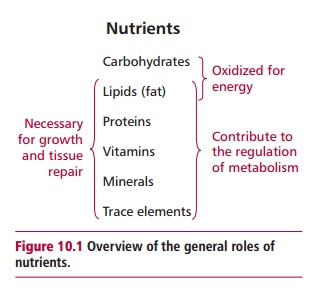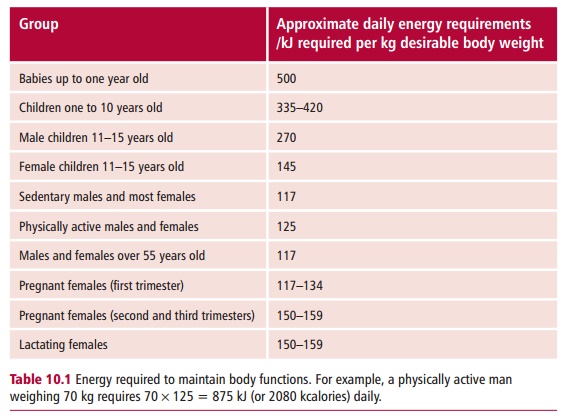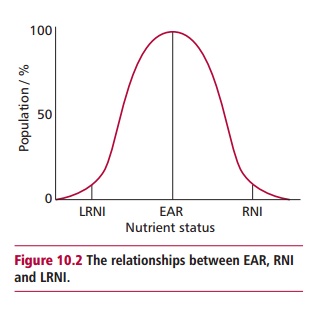Chapter: Biology of Disease: Diet and Disease
Nutrients and Energy - Diet and Nutrition
NUTRIENTS AND ENERGY
Diets are often described in terms of their energy
content, despite the fact that they need to supply materials for needs other
than just their energy provision (Figure
10.1). It is possible for a diet to supply an adequate amount of energy but
be deficient in some essential raw materials, such as vitamins and minerals
needed by the individual. A balanced
diet is one that supplies adequate energy distributed appropriately between
carbohydrates, lipids, and proteins and contains the necessary amounts of
vitamins, minerals, trace elements, water and nondigestible fiber.

Nutritional energy is usually measured in joules or
kilojoules. The number of joules required by any one person needs to be matched
to their energy output (Table 10.1).
The term recommended daily amount (RDA)
was originally used by the UK Department of Health in 1979 to define the
amounts of certain nutrients needed by different groups within the population.

Unfortunately, RDAs were often used inappropriately
to assess the dietary needs of individuals. Accordingly, in 1991, they were
replaced with dietaryreference values (DRVs) that are guidance values as to
the amounts of energyand nutrients that should be ingested, rather than exact
recommendations. Dietary reference values indicate the amount of energy or
amount of an individual nutrient required by a group of a certain age range and
sex for good health. The value of any DRV is given as a daily intake. However,
in practice DRVs must be determined from the energy and nutrient intakes
averaged from several days eating, because food intake and appetite vary from
day to day. Groups for which DRVs have been set include seven groups of infants
of both sexes from birth to age 10 years, four groups each for males and
females between the ages of 11 and 50-plus, with extra groups for women who are
pregnant or are lactating. The value of a DRV applies to healthy people, since
patients who are unwell for whatever reason may have differing nutritional
requirements. Dietary terms that are related to DRVs are the estimated averagerequirement (EAR), reference nutrient intake (RNI)
and lower reference nutrient intake (LRNI). The EAR is the mean amount of
energy or nutrientneeded by a population, while the RNI is an amount of a
nutrient that is greater than the dietary needs of 97.5% of that group. The
LRNI is the amount of a nutrient sufficient to meet the requirements of 2.5% of
a population. Note that most people will need more than the LRNI. Figure 10.2 shows how EAR, RNI and LRNI
are related. Finally, the safe intake
is the amount judged to be sufficient for the needs of most people and anything
below this level could be undesirable. This arbitrary value is given when there
is simply insufficient evidence to establish reliable values for EAR, RNI or
LRNI.

Related Topics